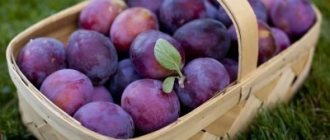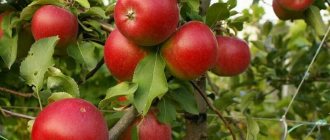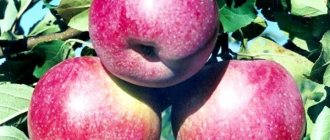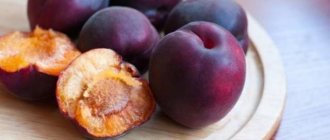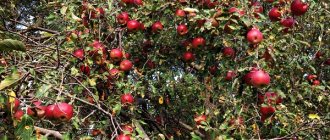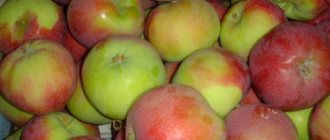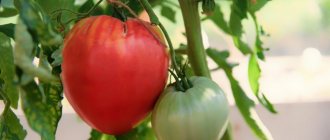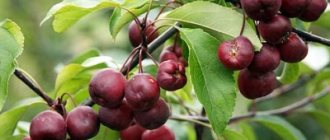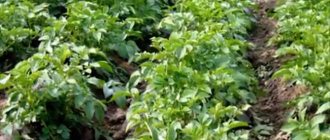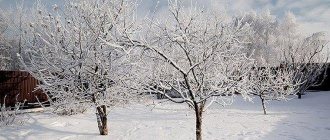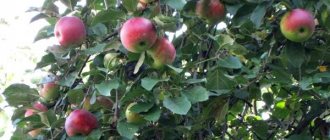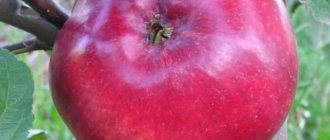Description
The apple tree variety Ainur is productive, late-winter and self-pollinating. The tree is small in size, the crown is round and compact. The growth is quite abundant, so the apple tree needs regular pruning.
Advantages and disadvantages
This variety combines positive qualities in the best possible way. Among them:
- excellent taste;
- resistance to low temperatures and climate change;
- immunity to fungal diseases;
- long shelf life of fruits.
Gardeners note that the Ainur apple tree varieties have absolutely no drawbacks.
Dimensions of an adult trunk
The Ainur apple tree is medium in size; it does not grow more than 3 meters, even without pruning. The crown is round, small, neat, although moderately spreading. In the first years, the apple tree has abundant annual growth, up to half a meter.
Sizes of an adult apple tree.
Fruiting
The apple tree is productive, there is an abundance of beautiful fruits on the branches. Their usual quantity is up to 35 kg. The harvest ripens at the same time, stays well and for a long time on the branches. The first fruits can be collected in the second year. The amount of harvest can be increased if you plant varieties nearby that bloom at the same time.
Tasting assessment
The apples earned a rating of 4.8 points and a maximum of 5 on the international tasting scale. He participated in various competitions more than once and took honorable places there. The pulp has a very pleasant consistency, juicy and aromatic. It has a pleasant, harmonious sweet and sour taste and a subtle aftertaste.
Disease resistance and frost resistance
The apple tree shows absolute resistance to scab and other fungal diseases. She is not affected by these diseases even in conditions of severe spread and epidemic.
Scab on an apple tree.
The Ainur apple tree tolerates low temperatures very easily. It is not afraid of return frosts and drought. The variety easily tolerates almost all climatic changes and adapts to them.
“Golden” apples from our own garden
Mature Golden Delicious apples, harvested with the arrival of the first days of autumn, can be perfectly stored until March.
Reference. Large and medium-sized yellow fruits have a sweet taste, low calorie content, and therefore are often used in dietary nutrition. They are recommended for preparing various dietary dishes; housewives willingly use them for filling pies and other baked goods.
With proper care of fruit-bearing trees, you can get significant yields from each - about 100-120 kg in one season.
Planting and care
The best time to plant this variety is spring. You need to choose a time before the buds bloom, but already when the soil has warmed up enough. In those regions where winter is not so severe, it can be planted in the fall, a few weeks before the first frost.
The place for Ainur to grow comfortably should be sunny and protected from the wind. It will be better if the groundwater is located as far away as possible, and the soil is sandy loam or loamy.
You need to select a seedling in advance. It must be visually healthy, without signs of defects, diseases or pests. If the variety is grafted, the grafting site should not be damaged or show signs of rot.
The pit is also prepared in advance. Its size should be such that the roots are comfortable and have enough space in width and depth. Nutrients, mineral fertilizers, and wood ash are placed in it. It is better to make drainage at the bottom.
Planting is carried out in the same way as with any other variety. A hill is poured at the bottom, on which the roots are installed. They are carefully straightened. The seedling is sprinkled with a layer of fertile soil so that the grafting site is not buried. It is better to tie it to a stake so that the seedling grows evenly.
Preparing a hole for planting an apple tree.
After planting, you will need to follow a number of simple rules for caring for the apple tree. These include:
- annual fertilizers three times per season, starting from the third year after planting;
- loosening the tree trunk circle and mulching it;
- timely pruning of the crown.
The variety is unpretentious and stable, so it does not need special care.
Although the apple tree easily adapts to low temperatures, it needs to be prepared for frost, especially when it comes to the Northern regions. To do this, the apple tree must be carefully examined for damage and, if necessary, pruned. The trunk needs to be whitened to destroy all the insects wintering there. To protect the trunk of a young apple tree from rodents, the trunk circle should be covered with spruce branches or paper. You also need to cover part of the trunk.
Altai apple tree Altynai
In the article you will learn the features of planting and caring for the Altynai apple tree in Altai, how to protect it from frost in winter, how to prevent moniliosis, and you will also be able to carefully study the photo and description of the variety.
The Altynai apple tree variety was selected by Ermakova N.V. and co-authors by crossing the well-known varieties Altai Velvet and Phoenix Altai at the NIISS named after. M. A. Lisavenko in 1965
The apple tree was bred specifically for planting in the lowlands and mountains of Altai. The variety was included in the State Register in 1999.
The trees grow medium-sized, they have a rounded crown with medium density of leaves. The branches are located at an angle of 90 degrees from the trunk, they have many ringlets and twigs. The grayish bark is covered with brown spots and stripes.
The shoots are thick, straight, brown, pubescent. Bright emerald leaves are medium in size, ovoid, short-pointed, wrinkled, not shiny, pubescent, with serrated, crenate, wavy edges. The petioles are short and thick.
The apples are medium in size (65-142 g), but for the Siberian Federal District they are quite large, round, somewhat flattened on top and bottom. The skin is smooth and thin.
The main color of the apples is cream, the outer color is rich salmon, almost the entire apple is covered with stripes and specks. The stalk is medium in size, the funnel is medium in depth, narrow.
The pulp is pleasant to the taste, snow-white, but with pale light green veins, has sweetness and acidity, juicy, and quite dense.
Apple tree Altynai.
additional characteristics
Advantages and disadvantages
Advantages:
- beautiful in appearance, very smooth, good taste, fairly large apples compared to other varieties grown in the Siberian Federal District;
- trees are not affected by scab.
Minuses:
- apple trees may freeze in the most severe frosts;
- The variety is not resistant to moniliosis.
Dimensions of an adult tree, annual growth
Medium sized tree. In unfavorable weather it grows no higher than 2 m.
The crown does not require shaping, since it is already compact.
Productivity, frequency of fruiting
The fruits are set on the tree every year. Productivity is average. Thus, in Gorno-Altaisk, 20.9 kg of apples were harvested from a seven-year-old tree, the average yield over 19 years was 8.8 t/ha
The Altynai apple tree has an average yield.
Tasting assessment
Compound:
- fructose, glucose, sucrose - 11.0%;
- vitamin C - 12.8 mg/100g;
- malic and other acids - 0.54%;
- pectin substances - 2.44% by dry weight.
Winter hardiness
The Altynai apple tree has average frost resistance and can freeze by 2-3 points in severe frosts.
Disease resistance
Apple trees have excellent immunity to scab, which is very important for Altai, since during the season 70% of apple tree treatments are aimed at eliminating scab.
Moniliosis affects people to a moderate degree. To prevent the tree from contracting moniliosis, even before it blooms, in early spring it is treated with copper-containing preparations, for example, 1% Bordeaux mixture.
Moniliosis of apple tree.
Reviews
Tatyana, Russia, Usolye-Sibirskoye. “Apples are about 65 g, these are quite large apples for the Siberian region. The taste of apples is without the astringency that is inherent in ranetki, it is purely apple.”
Natalya, Biysk district of Altai Territory. “My trees grow in a slate-bush form. They survived the frosts well and are not affected by scab at all. Very early in the spring I spray the trunks with Oksikhom and Abiga-pik so that the trees do not get moniliosis. For the winter I tie the trees with old tights.
Apples are beautiful, tasty, healthy, and contain a lot of vitamins. They last for quite a long time, maintaining their appearance and without losing their wonderful taste.”
Svetlana, Rubtsovsky district, Altai Territory. “In July, I sow sunflowers between the rows of apple trees. For the winter, I tie the trees with spruce branches; the smell of the pine needles repels mice and rodents. The apple trees seem to be surviving the frosts calmly for now. In the spring I cut off frozen and dry branches, and then treat the wounds with garden varnish.
By the end of September I collect the fruits. The apples look even and smooth. The whole family really likes the taste of apples. I make preserves and jams from fruits, bake charlotte, squeeze apple juice.”
Features of planting and care
Landing
Timing and scheme
Dig planting holes in advance with a diameter of 1 m and a depth of 60-80 cm.
If you plan to plant an apple tree in an area located in a region with a warm climate, then choose an open place.
If you are planting an apple tree in the North, then choose a place that is not blown by the winds.
The tree is planted in the spring, when the buds have not yet begun to bloom. And the planting holes are prepared in the fall.
Attention! In Siberia they are planted in early May, and in the central regions of Russia - in April.
Technology
Fill the hole with the top layer of soil mixed with fertilizers, leaves and humus. Before placing the seedling in the hole, thoroughly water the soil with warm water.
Drive a peg into the middle, and on the south side, place a seedling on the formed tubercle, straighten its roots and add soil.
Do not forget that the root collar should rise above the surface of the earth. The planted tree is watered with 2-3 buckets of water.
After planting, it is recommended to cover the seedlings with soil to a height of 15 cm, and to insulate the roots, add humus and peat under the tree.
Planting pit diagram.
Agricultural technology
Early in spring, clear the snow near the tree and trample it down. In the spring, spray the trunk with a weak solution of urea. Whiten the trunk of a young apple tree with chalk, and an adult tree with lime.
2-3 years after planting, start fertilizing:
- The first time this is done is early in the spring. You can add 30 g of nitroammophoska or 500 g of urea under one apple tree. Or you can add 3-4 buckets of humus;
- When the apple tree begins to bloom, apply a second liquid fertilizer. For example, dilute 10 g of sodium humate, 500 g of nitrophoska in a bucket of water;
- in July, feed the tree with potassium and phosphorus;
- In autumn, the apple tree also requires potassium and phosphorus. Take 1 tbsp. spoon of potassium, 2 tbsp. spoons of double superphosphate, pour into a ten-liter bucket of water. Pour a bucket of solution per 1 m².
For the successful growth and development of the apple tree, it is enough to water it three times a season, but the soil should be moist to a depth of 80 cm:
- water first when the buds open;
- then, when the apples ripen;
- the third watering is moisture-charging - in the fall.
Preparing for winter
Whiten the trunks and branches of young seedlings with chalk, and whiten the trunks of mature ones with lime. Fitoverm is added to whitewashing.
To protect the trunks from rodents in the fall, apple trees need to be tied with reeds, spruce branches, roofing felt, roofing felt, or wrapped with thick paper around the trunks. In the spring all this is removed.
Wrap apple trees in autumn with thick paper.
Growing in Siberia
You don’t have to loosen the soil around the tree trunk.
Gardeners even plant some plants near the tree trunk, for example strawberries, then the ground will be covered and this will protect the roots from sudden changes in weather, which is typical for the Altai region.
Water the apple tree in the first half of the warm season, when the snow melts. After fruit set, watering is stopped.
To prevent snow from accumulating in the winter between the rows, you can sow mustard and sunflower there in the middle of summer.
In the spring, before the sap begins to flow, frozen and dry branches are cut off. The wounds must be covered with garden varnish. There is no need to shape the crown; it is already very compact and neat.
Pollinator varieties
The following are planted as pollinator trees:
- Altai Velvet;
- Gornoaltaiskoe;
- Altai News;
- Pepinka Altai.
Pepinka Altai is one of the pollinators of Altyn.
Features of ripening and fruiting
Beginning of fruiting
The fruits begin to ripen 4-5 years after planting, that is, the precocity is average.
Deadlines
Blooms
The trees bloom in early June.
Fruit ripening
Apples can be picked starting from the second half of September.
Altynai apples ripen at the end of September.
Harvest storage
They are stored for quite a long time, about 4 months.
Favorable areas for growing
The Altynai apple tree is recommended for planting in the West Siberian region. But it can be grown in the Central Federal District of Russia, in the Primorsky Territory.
Useful videos
Watch a video about what moniliosis is and how to fight it: Watch a video on how to prepare trees for winter:
Watch a video on how to plant an apple tree when groundwater is close to the ground: Watch a video on how to properly prune an apple tree:
Conclusion
The Altynai apple tree variety is perfect for growing in the Altai region; the apples have excellent taste.
But trees must be prepared for winter by covering them with dry leaves and tying the trunks with roofing felt, roofing felt, and thick paper. Then they will definitely thank you with an excellent harvest.
sadsezon.com
Crown formation
Although the apple tree itself is small and compact, it is important to monitor the condition of the crown. The first three years will need to be trimmed to 30 cm of growth, because it is quite noticeable.
Starting from the fourth year of life, the apple tree will stop the active development of shoots. Only 5-8 cm of growth will need to be removed. But it is important to carry out sanitary pruning. You need to remove dry and damaged branches that do not bear fruit but thicken the crown.
Apple tree pruning diagram.
Ripening time and yield
The apple tree is considered early-bearing, and the first fruits can be collected from it within 3 years after planting. Growing on a dwarf rootstock, which is quite possible, can even speed up this process.
The tree usually blooms in the second half of May. Often this deadline is missed and postponed to the end of the month. Flowering is abundant, but not long-lasting, no more than a week.
The yield is high: from one small tree you can collect 25-35 kg of fruit. Fruit picking usually takes place at the end of September. They are immediately ready to eat. They make very tasty desserts, compotes and jams. The fruits can be stored for a long time until May and can easily be transported.
Apple harvest.
Apple tree variety Ainur | Yabloki.by
Ainur is an early winter variety of apple trees, bred at the Kazakh Research Institute of Fruit Growing and Viticulture as a result of crossing Aport with Golden Delicious.
The tree grows of medium size. The crown of the tree is round and compact.
The fruits grow large. Their average weight is about 140 grams. They grow about the same size. The apples are round-conical in shape. The fruits are golden yellow with a beautiful blush on the side where the sun's rays hit. The pulp of the apples is cream-colored and medium in density. The fruits taste sweet and sour with a pleasant aroma. They are very juicy, which is favorable for preparing juice from the fruits of this variety.
The variety is classified as a fast-bearing apple tree, since apples can be picked from the trees by the third year after planting. The harvest is annual and quite abundant. The fruits are harvested from the tree at the end of September. Apples are able to retain their taste and appearance until the beginning of spring. Try this website.
The variety is frost-resistant. Speaking about diseases, it should be noted that trees practically do not suffer from fungi.
The advantages of the variety include good frost resistance and resistance to fungal diseases.
yabloki.by
Growing Tips
The apple tree is unpretentious and undemanding. It is very easy to grow, without any possible difficulties. But it is worth paying attention to protecting the planting from various pests. They often settle on young shoots and eat them. To prevent their appearance, you need to carry out preventive spraying in the spring, as well as carefully inspect the plantings during the season.
Despite good immunity, the variety sometimes suffers from rust or fruit rot. To avoid such a problem, it will be necessary to spray with copper-containing preparations in the spring.
Reviews
Mikhail Petrovich, 58 years old, Barnaul: “At first it seemed that the Ainur apple tree would not get along with our frosts. But no, the seedling quickly took root and began to grow easily. Already in the third year we tried fruits. And what apples they are: juicy and sweet, very tasty.”
Alina, 33 years old, Altai Republic: “Very tasty apples, you just can’t stop eating them. They lie there for a long time, until spring. And the apple tree does not require any care at all, does not get sick and does not freeze.”
